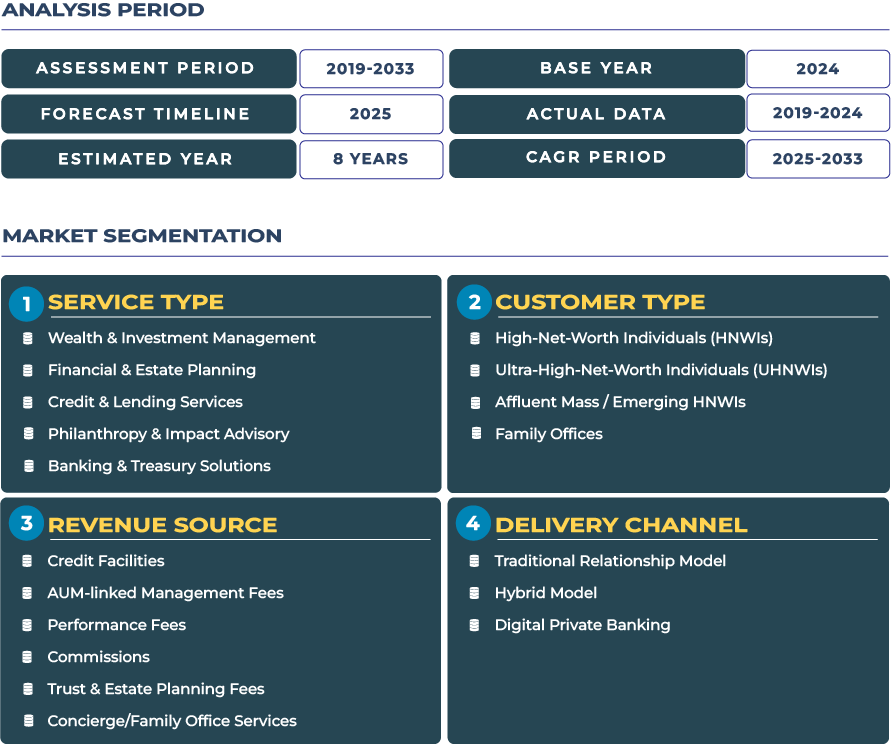Market Outlook: Charting India Private Banking Growth Trajectory Through to 2033
The market outlook for India private banking sector reveals a phase of sustained expansion and structural depth. From a base estimation of USD 35.0 billion in 2025, advancing to USD 68.5 billion by 2033 at an average CAGR of 8.8 %, the opportunity in India is both quantitative and qualitative. This growth reflects not just rising affluent portfolios but also an evolving client expectation that demands integrated wealth-journeys, digital access and global investment reach.
Note:* The market size refers to the total revenue generated by banks through various services.
Consider the rising prominence of tech-entrepreneurs, the expanding family-office segment and the growing interest of Indian HNWIs in alternative investments and cross-border diversification. Meanwhile, regulatory reforms, digital financial-inclusion policies and burgeoning fintech ecosystems underpin the supply side. For private banking firms, capturing this growth curve means investing in digital infrastructure, enriching service breadth, setting up advisory platforms in emerging wealth centres such as Bengaluru, Hyderabad and Pune, and building global-capability corridors. The next eight years are therefore characterised by both scale and sophistication: volume growth, but more importantly structural transformation of how wealth is managed.
Drivers of Momentum & Structural Headwinds: What Elevates and What Constrains India Private Banking Industry
Driving forces: The India private banking market is propelled by several deep-rooted drivers. First, the booming start-up ecosystem and domestic wealth creation are generating new high-net-worth segments, which in turn demand private banking services. Second, the financialisation of savings is accelerating-India mobile wallets, digital wealth platforms and mutual-fund penetration are opening up new investor bases and advisory opportunities. Third, technology innovation is transforming delivery: mobile-wealth applications, digital onboarding, robo-advisory and data-driven credit/treasury offers are enabling private banks to scale to a broader client base, including from Tier II cities, while maintaining service quality.
Growth headwinds: Yet, the market is not without its constraints. Uneven wealth distribution remains a structural restraint-while metros house substantial HNWI populations, Tier II and Tier III markets are still building scale. Tax complexity and succession regulation in India add layers of advisory burden for private banking firms and clients alike. Advisory awareness among nascent affluent segments is still evolving, meaning private banks must invest more deeply in education and service design. Also, competition from wealth-tech newcomers and digital assets is putting margin pressure on traditional private banking models. Navigating these headwinds effectively will differentiate winners in this rapidly evolving private banking ecosystem.
Trend-Vectors & Opportunity Frameworks: Digital Wealth Super-Apps, ESG Startup Investments and Tier-II City Penetration in India Private Banking Market
Emerging trends: India private banking sector is witnessing the rise of digital wealth super-apps-platforms that knit investment advisory, credit/treasury, payments and legacy-planning into a single mobile experience. This trend aligns with India broader digital-finance agenda, making private banking more accessible, dynamic and service-driven. Another emerging trend is the increasing flow of capital into ESG-led start-ups and impact investing, with HNWIs directing wealth toward purpose-driven ventures, creating demand for impact advisory within private banking. Additionally, penetration into Tier II cities (cities beyond the traditional metro hubs) is accelerating, as wealth concentration broadens and affluent families seek service locally but globally.
Opportunity frameworks: For private banks in India, key opportunity areas include expanding family-office services to cater to emerging entrepreneur families with multi-generational wealth, investment structuring, and legacy planning. The adoption of digital relationship managers and AI-powered portfolio tools will enable scale while enhancing personalisation. Additionally, providing access to alternative assets such as private equity, real assets, and venture investments will appeal to affluent clients seeking diversification. Effective execution of these frameworks will be critical to capturing the projected 8.8% CAGR and shaping the future of India’s private banking ecosystem.
Competitive Landscape: Service Innovation and Market Positioning in India Private Banking Sector
The competitive landscape within India private banking market is increasingly dynamic and innovation-driven. One prominent institution, HDFC Bank, announced expansion of its private-banking business and digital wealth platforms, reinforcing the strategic imperative of digital-first models. Within India, private banks and wealth-management arms are executing multiple strategic levers: segmentation of clients, deployment of mobile-first platforms, expansion into non-metro centres, and partnerships with fintechs for embedded wealth/credit/treasury flows. Success in this environment is determined by how well private banking firms integrate wealth & investment management, estate & legacy planning, credit & lending services, philanthropy & impact advisory and banking & treasury solutions into coherent client-journeys tailored for India wealthy and digitally-savvy clientele.







